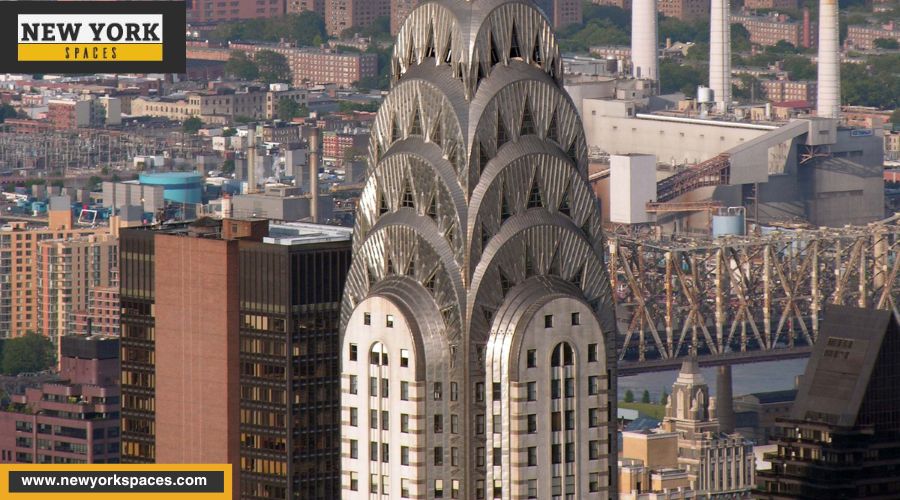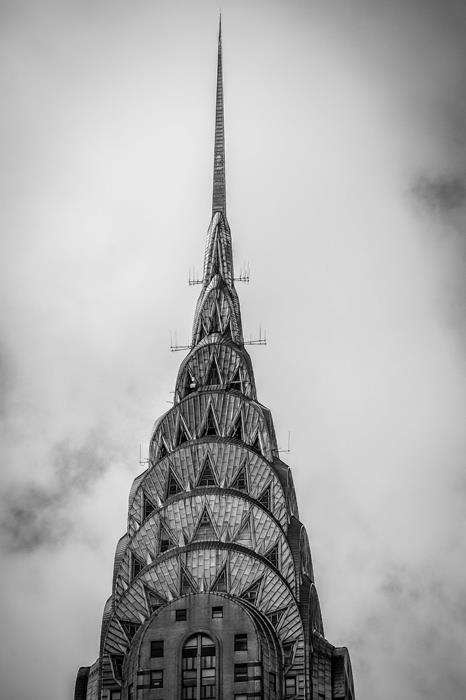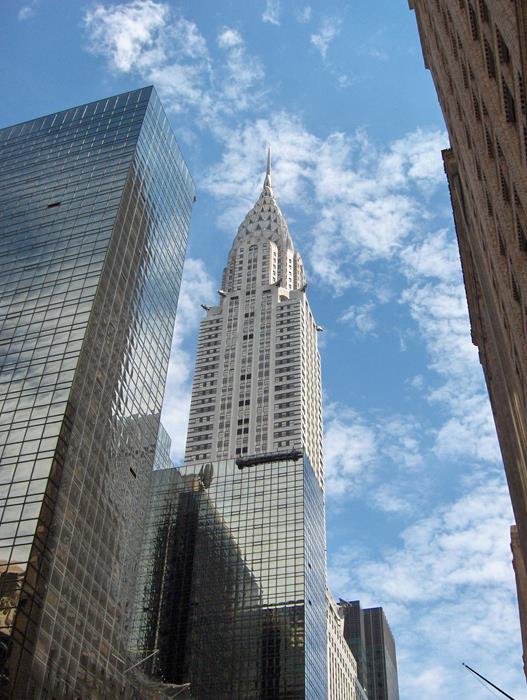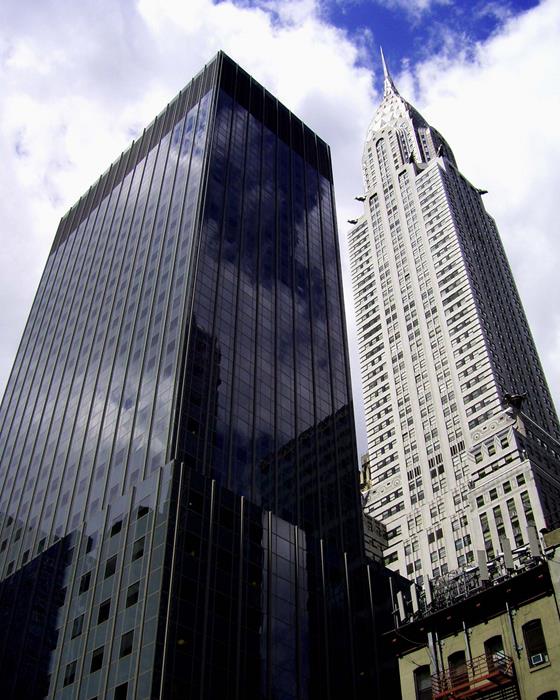In the heart of New York City stands the Chrysler Building, an emblem of the Art Deco era and a remarkable achievement in 20th-century architecture. Completed in 1930, this skyscraper was the brainchild of automotive mogul Walter P. Chrysler and was brought to life by architect William Van Alen. With its height of 1,046 feet, marked by a distinctive terraced crown, the building was briefly the world’s tallest before being surpassed by the Empire State Building.
Learn about the fascinating history of the Chrysler Building here:
Walter P. Chrysler’s Vision for the Chrysler Building
Walter P. Chrysler, the force behind the Chrysler Corporation, had a clear vision for the Chrysler Building: to create a structure that symbolized both his personal achievements and the might of the automotive industry. This skyscraper, located in New York City, was not a corporate endeavor but a personal project funded by Chrysler himself. He aimed to leave a lasting legacy for his family while also creating a prominent emblem for his company.
The Chrysler Building was designed to be more than an office space – it was a testament to the advancements and prosperity of the automotive industry in the early 20th century. Chrysler’s influence is evident in the building’s design, featuring Art Deco elements that mimic components of Chrysler automobiles, such as hood ornaments and radiator caps. These design choices were not just aesthetic; they symbolized the building’s connection to industry and innovation.
Chrysler’s personal investment in the project just shows how the building was a tribute to his success in the automotive industry, marking the building as a unique blend of personal legacy and industrial symbol.
Design and Construction of the Chrysler Building
The design and construction of the Chrysler Building was led by architect William Van Alen. His style was notably forward-thinking, and his approach to the Chrysler Building was no exception.
William Van Alen’s Architectural Approach
Van Alen’s design for the Chrysler Building was deeply rooted in the Art Deco movement, characterized by rich colors, bold geometric shapes, and lavish ornamentation. His approach was to create a building that was not just functional but also symbolically representative of the modern era, particularly the burgeoning automotive industry. The exterior of the building featured stainless steel and decorative elements such as the eagles and radiator cap gargoyles, inspired by Chrysler automobiles. This attention to detail and incorporation of modern motifs was revolutionary at the time and showcased Van Alen’s commitment to creating a building that was as much a piece of art as a functional space.
The Construction Process
The construction of the Chrysler Building was an ambitious project. The most fascinating aspect of its construction was the secret assembly and installation of the building’s 27-ton steel spire. In a bid to surpass 40 Wall Street and claim the title of the world’s tallest building, the spire was constructed inside the building and then assembled on top in a remarkably short time. This strategic move was kept a secret until the last moment and added a dramatic chapter to the building’s construction story.
The overall construction process also reflected the era’s technological advancements. The use of nearly 4 million bricks, laid by hand, and the incorporation of 391,831 rivets speak to the scale and complexity of the project. The building’s 77 floors and 34 elevators were designed to accommodate heavy daily usage, a testament to the foresight in its design and planning.
Architectural Features of the Chrysler Building
The Chrysler Building, a masterpiece of Art Deco architecture, is distinguished by its striking design elements both inside and out. The building’s design reflects the artistic and technological spirit of its time, showcasing both aesthetic beauty and functional ingenuity.
Exterior Art Deco Elements
The exterior of the Chrysler Building is a testament to the Art Deco style, characterized by geometric patterns, symmetry, and the use of modern materials. The most prominent feature is its crown, comprising seven radiating terraced arches. This crown is clad in Nirosta stainless steel, a material innovative for its time, and is adorned with triangular vaulted windows that contribute to the building’s distinctive silhouette.
Another defining feature of the Chrysler Building’s exterior is the presence of decorative gargoyles, which are inspired by automobile ornaments. These gargoyles, resembling radiator caps, and the eagle gargoyles on the 61st floor are symbolic nods to the Chrysler cars of the era, integrating industrial motifs into the building’s design. This blending of modern industrial elements with architectural design was groundbreaking and represented the height of technological and artistic achievement of the period.
Interior Design
Inside, the Chrysler Building continues its Art Deco theme. The lobby is a particularly striking example, adorned with Red Moroccan marble walls, a ceiling painted with a representation of the Chrysler car radiator cap, and ornamental friezes. The use of these luxurious materials and the attention to detail in the murals and fixtures exemplify the grandeur of the Art Deco era.
The elevators in the building are another highlight, each designed with unique inlaid wood motifs. These elevators reflect the era’s penchant for craftsmanship and luxury, blending functionality with elaborate artistry. The intricate designs vary from elevator to elevator, with each showcasing a different type of exotic wood and Art Deco pattern.
Competing for the Skies: The Chrysler Building in the Race for Height
In the late 1920s, New York City witnessed a remarkable competition in architectural history: the race to build the world’s tallest building. This period was marked by rapid technological advancements and a booming economy, setting the stage for an architectural showdown that would redefine the city’s skyline.
The Race for Height
The race to build the world’s tallest building was not just a matter of structural engineering; it was a symbol of prestige and progress. In this competitive atmosphere, the Chrysler Building emerged as a key contender. Walter P. Chrysler, aiming to create a lasting legacy, envisioned a building that would surpass all others in height and grandeur. The project was also a manifestation of the era’s industrial optimism and the ambition of American capitalism.
The Chrysler Building’s Ascent
Under the guidance of architect William Van Alen, the Chrysler Building’s construction proceeded at an unprecedented pace. The most dramatic moment in this race came with the secret assembly and installation of the building’s spire. This stainless steel spire, fabricated in sections and erected within a remarkably short period, catapulted the Chrysler Building to a height of 1,046 feet, allowing it to briefly hold the title of the world’s tallest building upon its completion in 1930.
Rivalry with Other Skyscrapers
The Chrysler Building’s main rival in this race was 40 Wall Street, also known as the Bank of Manhattan Trust Building. Just as the Chrysler Building was nearing completion, 40 Wall Street claimed the title of the world’s tallest building. However, the addition of the Chrysler Building’s spire reversed this claim. This triumph was short-lived, as the Empire State Building, completed in 1931, ultimately surpassed both structures in height.
Legacy of the Competition
The competition among these skyscrapers was more than a race for height; it represented the spirit of an era that valued innovation, ambition, and the symbolic power of architecture. The Chrysler Building, even after losing its title, remained an architectural marvel and a symbol of the times. Its brief tenure as the world’s tallest building is a significant chapter in the history of skyscraper construction, illustrating the combination of architectural creativity and the competitive drive of the period.
Preservation and Legacy of the Chrysler Building
Over the years, the Chrysler Building has faced various challenges, yet its significance and legacy continue to endure in modern times.
Navigating Challenges
Ownership changes have been a notable challenge for the Chrysler Building. Since its completion, the building has been passed through different hands, which at times brought uncertainties about its maintenance and preservation. Despite these transitions, successive owners have recognized the building’s historical importance, leading to efforts to maintain and preserve its original Art Deco style and structural integrity.
Another challenge has been keeping the building relevant and competitive amid New York City’s ever-evolving architectural landscape. The rise of new skyscrapers equipped with modern amenities posed a challenge to older buildings like the Chrysler Building in attracting tenants. However, its historical significance and unique architectural features have continually drawn interest and admiration.
Historical Significance and National Recognition
The Chrysler Building was designated a National Historic Landmark in 1976, a recognition that highlights its importance in American architectural history. This designation is a testament to the building’s architectural innovation, its role in the development of skyscrapers, and its status as a symbol of the Art Deco era.
The building’s legacy in modern times remains strong. It is not only an integral part of New York City’s skyline but also a symbol of architectural excellence and historical significance. Its unique style, historical importance, and enduring presence have made it a subject of study and admiration for architects, historians, and the general public.
The Chrysler Building continues to be a beacon of 20th-century architecture, representing the innovation, ambition, and creativity of its era. Its preservation as a historical landmark ensures that it remains a cherished part of New York City’s architectural heritage, appreciated by generations past and present.
Fun Facts About the Chrysler Building
- The Chrysler Building’s iconic spire was constructed in secret and hoisted into place in just 90 minutes, a strategic move to win the title of the world’s tallest building in 1930. The building’s iconic spire weighs 27 tons and was assembled secretly to achieve the title of the world’s tallest building in 1930.
- It’s one of the finest examples of Art Deco architecture in the world, featuring geometric patterns, lavish decorations, and motifs inspired by the automotive industry.
- The building’s 71st-floor observatory, known as “Celestial,” once offered visitors views of up to 160 kilometers on a clear day. It was adorned with cosmic designs and glass planets.
- Walter Chrysler had a private apartment and office on the 69th and 70th floors, complete with a fireplace and gymnasium.
- The Chrysler Building has made numerous appearances in films and television shows, becoming a symbol of New York City in popular culture.
- Various elements of the building are inspired by automotive designs, particularly the Plymouth cars by the Chrysler Corporation. The building features gargoyles shaped like Chrysler radiator caps and eagles reminiscent of hood ornaments.
- The Cloud Club, once a private club on the 66th to 68th floors, featured lavish interiors, including a Tudor-style dining room and a Renaissance-inspired staircase.
- The Chrysler Building is one of the few buildings in New York with its own ZIP code – 10174.
- With its steel framework, it is the tallest brick building in the world.
- Initially receiving mixed reviews, the Chrysler Building is now hailed as an architectural and cultural icon, representing the ambition and innovation of its time.
- With its 77 floors and 34 elevators, the Chrysler Building stands as a testament to early 20th-century architectural and engineering prowess.
- Despite its grandeur, the construction of the Chrysler Building cost a relatively modest $15 million, a testament to the efficiency and ingenuity of its design and construction process.
- A total of 391,831 rivets were used in its construction.
- Contrary to common belief, the Chrysler Building was named after Walter Chrysler himself, not the Chrysler Corporation, reflecting its role as a personal project and legacy.
- Approximately 4 million bricks were laid by hand to create the Chrysler Building, illustrating the meticulous craftsmanship that went into its construction.
- In 1976, the building was rightly declared a National Historic Landmark, cementing its status as an integral piece of American architectural heritage.
- During its heyday, the building housed the elite Cloud Club, which counted among its members notable figures like Condé Nast and boxer Gene Tunney. The club was a casualty of the economic crisis of the 1970s.
- The lobby of the Chrysler Building features the world’s first digital clock, showcasing the building’s embrace of modern technology and innovation from its inception.
Conclusion
The Chrysler Building, a towering presence in New York City’s skyline, is a masterpiece of architectural design, representing the innovation and spirit of an era driven by progress and ambition.
As an exemplar of the Art Deco movement, the building captures the essence of the 1920s and 1930s—a time when society was enjoying technological advancements and an optimistic outlook toward the future.
Today, the Chrysler Building remains an enduring legacy of a bygone era, a testament to human creativity, and a symbol of architectural brilliance. Its presence in the heart of New York City continues to inspire awe and admiration, maintaining its status as one of the most iconic buildings in the world.




